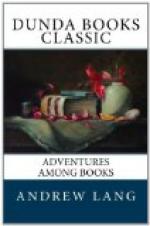To myself “The House of the Seven Gables” has always appeared the most beautiful and attractive of Hawthorne’s novels. He actually gives us a love story, and condescends to a pretty heroine. The curse of “Maule’s Blood” is a good old romantic idea, terribly handled. There is more of lightness, and of a cobwebby dusty humour in Hepzibah Pyncheon, the decayed lady shopkeeper, than Hawthorne commonly cares to display. Do you care for the “first lover,” the Photographer’s Young Man? It may be conventional prejudice, but I seem to see him going about on a tricycle, and I don’t think him the right person for Phoebe. Perhaps it is really the beautiful, gentle, oppressed Clifford who haunts one’s memory most, a kind of tragic and thwarted Harold Skimpole. “How pleasant, how delightful,” he murmured, but not as if addressing any one. “Will it last? How balmy the atmosphere through that open window! An open window! How beautiful that play of sunshine. Those flowers, how very fragrant! That young girl’s face, how cheerful, how blooming. A flower with the dew on it, and sunbeams in the dewdrops . . . " This comparison with Skimpole may sound like an unkind criticism of Clifford’s character and place in the story—it is only a chance note of a chance resemblance.
Indeed, it may be that Hawthorne himself was aware of the resemblance. “An individual of Clifford’s character,” he remarks, “can always be pricked more acutely through his sense of the beautiful and harmonious than through his heart.” And he suggests that, if Clifford had not been so long in prison, his aesthetic zeal “might have eaten out or filed away his affections.” This was what befell Harold Skimpole—himself “in prisons often”—at Coavinses! The Judge Pyncheon of the tale is also a masterly study of swaggering black-hearted respectability, and then, in addition to all the poetry of his style, and the charm of his haunted air, Hawthorne favours us with a brave conclusion of the good sort, the old sort. They come into money, they marry, they are happy ever after. This is doing things handsomely, though some of our modern novelists think it coarse and degrading. Hawthorne did not think so, and they are not exactly better artists than Hawthorne.
Yet he, too, had his economies, which we resent. I do not mean his not telling us what it was that Roger Chillingworth saw on Arthur Dimmesdale’s bare breast. To leave that vague is quite legitimate. But what had Miriam and the spectre of the Catacombs done? Who was the spectre? What did he want? To have told all this would have been better than to fill the novel with padding about Rome, sculpture, and the Ethics of Art. As the silly saying runs: “the people has a right to know” about Miriam and her ghostly acquaintance. {10} But the “Marble Faun” is not of Hawthorne’s best period, beautiful as are a hundred passages in the tale.
Beautiful passages are as common in his prose as gold in the richest quartz. How excellent are his words on the first faint but certain breath of Autumn in the air, felt, perhaps, early in July. “And then came Autumn, with his immense burthen of apples, dropping them continually from his overladen shoulders as he trudged along.” Keats might have written so of Autumn in the orchards—if Keats had been writing prose.




